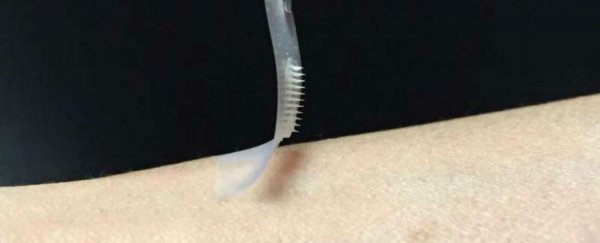A new 'smart patch' lined with painless microneedles full of insulin has been developed by researchers in the US in an effort to do away with the uncomfortable injections that have become a part of life for the millions of type 1 diabetics around the world who need to manually regulate their hormone levels.
The 4-cm patch features more than a 100 of these eyelash-sized microneedles, and not only go they contain enough insulin to provide the same dosage as a single injection, but they also contain glucose-sensing enzymes that can identify when blood-sugar levels are too high and release the insulin into the blood stream.
"We have designed a patch for diabetes that works fast, is easy to use, and is made from nontoxic, biocompatible materials," said one of the researchers, Zhen Gu, from the joint University of North Carolina/NC State's Department of Biomedical Engineering. "The whole system can be personalised to account for a diabetic's weight and sensitivity to insulin, so we could make the smart patch even smarter."
The patch has been tested in mouse models and so far, looks very promising. According to the paper published in the Proceedings of the National Academy of Sciences, it was able to regulate the insulin levels of diabetic mice for nine hours straight. And obviously mice are useless at monitoring their blood-sugar levels the way human diabetics have to right now, which shows just how hands-off this new system is.
This doesn't just mean the patch will be a hell of a lot more convenient for its users than the injection system, it will also be far safer. As one of the team, John Buse, points out in the press release, getting your dosage wrong could lead to some of the worst outcomes you could imagine: "Injecting the wrong amount of medication can lead to significant complications like blindness and limb amputations, or even more disastrous consequences such as diabetic comas and death."
The system inside the patch was built to mimic the body's own insulin generators, known as beta cells. These highly specialised cells are responsible for both producing and storing insulin in little sac-like structures called vesicles. "We constructed artificial vesicles to perform these same functions by using two materials that could easily be found in nature," said one of the team, Jiching Yu.
These materials, hyaluronic acid and 2-nitroimidazole, were combined to make a new type of molecule, one end of which loves water - hydrophilic - and the other is repelled by it - hydrophobic. When great numbers of these molecules are mixed together, they automatically assemble into a vesicle structure, with the hydrophobic ends pointing inward and the hydrophilic ends pointing outward. The researchers inserted insulin and glucose-sensing enzymes into these vesticles.
When tested in the lab, the patch kicked into gear at the sign of increased blood sugar levels, and the excess glucose moved its way into the already-packed vesicles. The glucose was then converted into gluconic acid by the enzymes within, and the resulting lack of oxygen turned the hydrophobic 2-nitroimidazole molecules hydrophilic, which destroyed the structure of the vesticles and released the insulin. Genius.
"The hard part of diabetes care is not the insulin shots, or the blood sugar checks, or the diet, but the fact that you have to do them all several times a day every day for the rest of your life", said Buse. "If we can get these patches to work in people, it will be a game changer."
The next step will be to get the patch into clinical trials so it can hit the market, and to improve the technology so it will last several days, rather than several hours. We can't wait.
